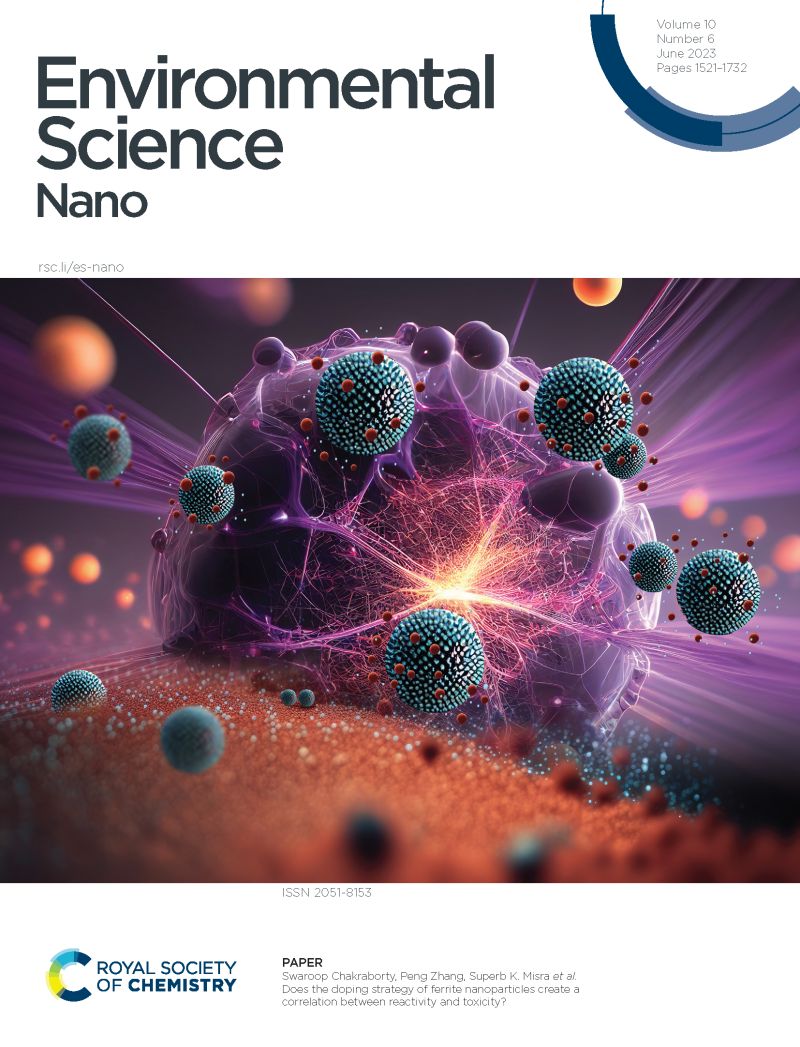Omics approaches in environmental effect assessment of engineered nanomaterials and nanoplastics
IF 5.8
2区 环境科学与生态学
Q1 CHEMISTRY, MULTIDISCIPLINARY
引用次数: 0
Abstract
In light of the increasing application of omics technologies, such as transcriptomics, proteomics, and metabolomics, in chemical safety evaluations and interest in using these advanced tools for regulatory toxicity testing, this review critically discusses the findings from omics studies involving engineered nanomaterials and nanoplastics in aquatic and terrestrial invertebrates, unicellular organisms (cyanobacteria, fungi, microalgae and protozoa), aquatic vertebrates (fish) and crop plants. The studies published over the past nine years were analyzed based on the nanomaterial types, organism groups, and the omics approaches used, with a focus on extracting information about toxicity mechanisms. Many of these studies highlighted the role of dissolved metal ions in the toxicity of soluble metal NPs such as Ag, ZnO, Cu- and Fe-based NPs. The results generally indicate that these NPs and respective released metal ions perturb different molecular pathways, particularly in the organisms or cells that internalize NPs by endocytic mechanisms. In contrast, non-soluble metal NPs (TiO2, CeO2, and SiO2 NPs) have proven relatively less acutely ecotoxic, but omics studies have revealed molecular pathway modulations, initiated by membrane interactions and cellular internalization. Overall, a common outcome of exposure to metal-based NPs is the disruption of energy metabolism. On the other hand, polymeric NPs, such as nanoplastics (primarily polystyrene NPs) tend to induce molecular-level events mainly by inducing oxidative stress. While a substantial amount of mechanistic data related to environmental nanotoxicity has been generated using omics methods, adverse outcome pathways (AOP) in ecotoxicology model organisms have only been proposed for Ag and polystyrene NPs. This indicates that New Approach Methodologies (NAMs) hold great potential for the safety assessment of nanomaterials in the environment, yet this potential has not been fully realized.鉴于组学技术(如转录组学、蛋白质组学和代谢组学)在化学品安全性评估中的应用日益广泛,以及人们对使用这些先进工具进行监管毒性测试的兴趣,本综述对涉及水生和陆生无脊椎动物、单细胞生物(蓝藻、真菌、微藻和原生动物)、水生脊椎动物(鱼类)和作物植物中的工程纳米材料和纳米塑料的组学研究结果进行了批判性讨论。我们根据纳米材料类型、生物类别和使用的 omics 方法对过去九年发表的研究进行了分析,重点是提取有关毒性机制的信息。其中许多研究强调了溶解金属离子在可溶性金属 NPs(如银、氧化锌、铜和铁基 NPs)毒性中的作用。研究结果普遍表明,这些 NPs 和各自释放的金属离子会扰乱不同的分子通路,特别是在通过内吞机制内化 NPs 的生物体或细胞中。相比之下,非可溶性金属 NPs(TiO2、CeO2 和 SiO2 NPs)被证明具有相对较低的急性生态毒性,但 omics 研究揭示了由膜相互作用和细胞内化引发的分子途径改变。总之,接触金属基 NPs 的一个共同结果是破坏能量代谢。另一方面,高分子 NPs,如纳米塑料(主要是聚苯乙烯 NPs)往往主要通过诱导氧化应激来引发分子水平的事件。虽然利用全息方法已经获得了大量与环境纳米毒性相关的机理数据,但只针对银和聚苯乙烯 NPs 提出了生态毒理学模式生物的不良结果途径 (AOP)。这表明,新方法(NAM)在环境中纳米材料的安全评估方面具有巨大潜力,但这种潜力尚未得到充分发挥。
本文章由计算机程序翻译,如有差异,请以英文原文为准。
求助全文
约1分钟内获得全文
求助全文
来源期刊

Environmental Science: Nano
CHEMISTRY, MULTIDISCIPLINARY-ENVIRONMENTAL SCIENCES
CiteScore
12.20
自引率
5.50%
发文量
290
审稿时长
2.1 months
期刊介绍:
Environmental Science: Nano serves as a comprehensive and high-impact peer-reviewed source of information on the design and demonstration of engineered nanomaterials for environment-based applications. It also covers the interactions between engineered, natural, and incidental nanomaterials with biological and environmental systems. This scope includes, but is not limited to, the following topic areas:
Novel nanomaterial-based applications for water, air, soil, food, and energy sustainability
Nanomaterial interactions with biological systems and nanotoxicology
Environmental fate, reactivity, and transformations of nanoscale materials
Nanoscale processes in the environment
Sustainable nanotechnology including rational nanomaterial design, life cycle assessment, risk/benefit analysis
 求助内容:
求助内容: 应助结果提醒方式:
应助结果提醒方式:


